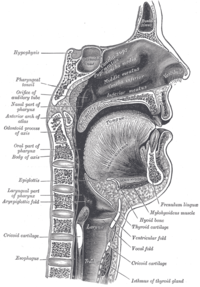
Photo from wikipedia
PURPOSE The purpose of this study was to index cognitive resource usage for acquisition of initial targets of two common voice therapy techniques (resonant voice therapy [RVT] and conversation training… Click to show full abstract
PURPOSE The purpose of this study was to index cognitive resource usage for acquisition of initial targets of two common voice therapy techniques (resonant voice therapy [RVT] and conversation training therapy [CTT]) based on the theorized depletion effect (i.e., when an initial task requiring high cognitive load leads to poorer performance on a subsequent task). METHOD Eleven vocally healthy participants, ages 23-41 years, read aloud the Rainbow Passage and produced consonant-vowel resonant targets (/mi, ma, mu/) followed by a baseline computerized Stroop task and a 15-min washout. Following this baseline period, participants watched and interacted with two videos instructing them in RVT or CTT initial targets. After viewing each video and practicing the associated vocal skills, participants rated the degree of mental effort required to engage in the target vocal technique on a modified Borg scale. Participants recorded their attempts at RVT on /mi, ma, mu/ and CTT on the Rainbow Passage, which were later rated by three voice-specialized speech-language pathologists as to how representative they were of each respective target technique. Changes in fundamental frequency and average auditory-perceptual ratings from baseline were examined to determine if participants adjusted their technique from RVT and CTT baseline to acquisition. RESULTS Performance on the Stroop task was, on average, worse post CTT than post RVT, but both post-CTT and post-RVT Stroop scores were poorer than baseline. These results suggest that both treatment techniques taxed cognitive resources but that CTT was more cognitively taxing than RVT. However, despite differences in raw averages, no statistically significant differences were found between the baseline, post-CTT, and post-RVT Stroop scores, likely due to the small sample size. Participant ratings of mental effort for CTT and RVT were statistically similar. Likewise, poorer post-RVT Stroop scores were associated with participants' greater perceived mental effort with RVT acquisition, but there was no significant association between mental effort ratings for CTT acquisition and post-CTT Stroop scores. Significantly higher fundamental frequency and perceived ratings of the accuracy of technique from baseline to acquisition for both CTT and RVT were found, providing evidence of vocal behavior changes as a result of each technique. CONCLUSIONS Brief exposure to initial treatment tasks in CTT is more cognitively depleting than initial RVT tasks. Results also indicate that vocally healthy participants are able to make a voice change in response to a brief therapy prompt. Finally, participant-rated measures of mental effort and secondary measures of cognitive depletion do not always correlate.
Journal Title: American journal of speech-language pathology
Year Published: 2023
Link to full text (if available)
Share on Social Media: Sign Up to like & get
recommendations!